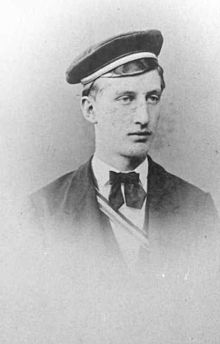Carl Meinhof
Carl Friedrich Michael Meinhof (born July 23, 1857 in Barzwitz near Rügenwalde in Western Pomerania ; † February 11, 1944 in Greifswald , buried in the Ohlsdorf cemetery in Hamburg) was a Protestant pastor and Africanist .
In 1909 Carl Meinhof held the first professorship for African Studies in Germany in Hamburg . Meinhof previously worked as a language teacher at the Department of Oriental Languages at the University of Berlin. He retired in 1936 at the age of 79, and was succeeded by August Klingenoben .
Life
Carl Meinhof was a son of the pastor and revival preacher Friedrich Meinhof (1800-1881) and his third wife Clara Christiane Giesebrecht (1819-1893). He studied at the universities in Erlangen and Greifswald . There he became a member of the Erlanger and Greifswalder Wingolf . He then continued his studies in Tübingen . In 1886 he became a pastor in Zizow , a Pomeranian village near Rügenwalde. In his free time he was engaged in philological studies. By chance he came into contact with African languages through a neighboring manor : he was supposed to give German lessons to a Duala boy who lived there . He was married to Elly Heyer (1858-1894) from 1882 to 1894 and from 1895 until his death in 1944 to Anna Kloss (1866-1944). Meinhof had a total of twelve children, three of whom died prematurely. Meinhof became a member of the NSDAP in May 1933 . In November 1933 he signed the German professors' confession of Adolf Hitler .
Scientific work
One of the most important works of Meinhof was a comparative grammar of the Bantu languages . Based on the pioneering work of Wilhelm Bleek , he developed a systematic collection and research of African languages and traditions. For example, he recorded traditional African music with a phonograph in Tanzania as early as 1902 and published collections of African fairy tales .
Meinhof developed the linguistic Hamite theory further, according to which the light-skinned North African peoples and their descendants represent a “ master race ” more highly developed within Africa . In particular, he tried to prove that the Bantu peoples emerged from a merger of Hamitic and non-Hamitic African peoples. Likewise, the "Hottentots" (today: Nama ) arose from a merger of Hamites and "Bushmen" (today: San ).
Writings (monographs)
- Outline of a phonology of the Bantu languages together with instructions for the inclusion of Bantu languages. Leipzig 1899
- The Christianization of the Languages of Africa. Basel 1905
- Basics of a comparative grammar of the Bantu languages. Berlin 1906
- Textbook of the Nama language. Berlin 1909.
- The Herero language in German South West Africa. Berlin 1909
- The Swahili language in German East Africa. Berlin 1910
- The Hamite languages. Friederichsen, Hamburg 1912
- The language of the Duala in Cameroon. Berlin 1912
- A study trip to Kordofan , Friederichsen, Hamburg 1916
- as editor: African fairy tales. Diederichs, Jena 1917
- The emergence of inflected languages. Berlin 1936
- Basics of a comparative grammar of the Bantu languages. Second completely reworked edition . Eckhardt & Messtorff, Hamburg 1948 (published posthumously)
literature
- Ernst Dammann: Meinhof, Carl. In: New German Biography (NDB). Volume 16, Duncker & Humblot, Berlin 1990, ISBN 3-428-00197-4 , p. 670 f. ( Digitized version ).
- Rainer Hering: MEINHOF, Carl Friedrich Michael. In: Biographisch-Bibliographisches Kirchenlexikon (BBKL). Volume 17, Bautz, Herzberg 2000, ISBN 3-88309-080-8 , Sp. 921-960.
- Herrmann Jungraithmayr, Wilhelm JG Möhlig (Hrsg.): Lexicon of African Studies . Dietrich Reimer, Berlin 1983, ISBN 3-496-00146-1
- Hilke Meyer-Bahlburg, Ekkehard Wolff: African languages in research and teaching: 75 years of African studies in Hamburg (1909-1984) . Dietrich Reimer, Berlin 1986, ISBN 3-496-00828-8
- Sara Pugach: "Christianize" and Conquerer: Carl Meinhof, German Evangelical Missionaries, And The Debate over African Languages 1905-19010. In: Ulrich van der Heyden; Jürgen Becher: Mission and Violence. Steiner Verlag, 2000
Web links
- Literature by and about Carl Meinhof in the catalog of the German National Library
- Newspaper article about Carl Meinhof in the 20th century press kit of the ZBW - Leibniz Information Center for Economics .
Individual evidence
- ↑ 11 February 1944 died Rainer Hering: MEINHOF, Carl Friedrich Michael. In: Biographisch-Bibliographisches Kirchenlexikon (BBKL). Volume 17, Bautz, Herzberg 2000, ISBN 3-88309-080-8 , Sp. 921-960.
- ↑ Complete directory of Wingolf, Lichtenberg 1991
- ↑ H.Meyer-Bahlburg / E. Wolff: African languages in research and teaching, p. 60.
| personal data | |
|---|---|
| SURNAME | Meinhof, Carl |
| ALTERNATIVE NAMES | Meinhof, Carl Friedrich Michael (real name) |
| BRIEF DESCRIPTION | German Africanist |
| DATE OF BIRTH | July 23, 1857 |
| PLACE OF BIRTH | Barzwitz near Rügenwalde |
| DATE OF DEATH | February 11, 1944 |
| Place of death | Greifswald |

